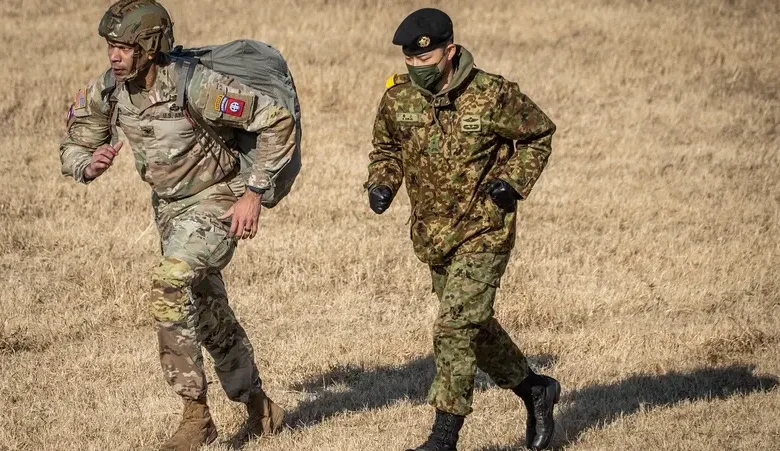US, Japan boost security, military cooperation

The United States and Japan plan to boost military and security cooperation as their top national security officials hold talks on Wednesday.
The US and Japanese foreign and defense ministers are set to agree to adjust the American troop presence on the island of Okinawa. And, as they prepared to meet, Japan’s defense ministry announced it was ready to start construction on an uninhabited island where the two militaries will hold joint military exercises.
The two nations are revising their joint defense posture as they confront rising threats from North Korea and increasing aggressiveness from China.
Wednesday’s discussions will be followed by a meeting on Friday between President Joe Biden and Japanese Prime Minister Fumio Kishida at which they will underscore the importance of the relationship.
Kishida, on a weeklong trip to visit allies in Europe and North America, signed a defense agreement with British Prime Minister Rishi Sunak on Wednesday that strengthens military ties between their two counties, also in response to China’s increasing military assertiveness.
Following their talks, Secretary of State Antony Blinken, Defense Secretary Lloyd Austin and their Japanese counterparts, Yoshimasa Hayashi and Yasukazu Hamada, plan to issue a joint statement that will adjust, but not increase, the American troop presence on Okinawa.
The statement also will add a formal mention of space in the longstanding security treaty, in a nod to the Pentagon’s creation of the Space Force and Space Command. According to an administration fact sheet, that means that “attacks to, from and within space” could trigger the mutual defense provisions of the treaty, something that had previously been outside the scope of the agreement.
And, earlier Wednesday, Japan said it would soon begin constructing a pair of runways on the small southern island of Mageshima where the two militaries are to conduct joint exercises, including those of F-35B stealth fighters, amphibious operations and missile interception beginning around 2027.
The construction could start as early as Thursday, it said. The island, off the southwestern coast of Kagoshima on the southernmost main island of Kyushu, will be a hub for troop deployment and munition supply in case of a conflict like a Taiwan emergency.
Japan and the United States are moving one of their key flight exercise sites to the southern island, which is much closer to the US air base of Iwakuni, home to an F-35B fleet, than the current training site on Iwo Jima, where one of the bloodiest and most iconic battles of World War II was fought.
The changes in the deployment on Okinawa will transform the 12th Marine Regiment into a smaller, more rapidly mobile unit — the 12th Marine Littoral Regiment, which will be designed to be better able and equipped to fight an adversary and defend the US and its allies in the region, US officials said.
The regiment “will bolster deterrence and provide a stand-in force that is able to defend Japan and quickly respond to contingencies,” the administration fact sheet said.
The officials said the decision will not increase the number of Marines on the island and does not come with any significant change in weapons capability.
Reinforcement of military capability or troops is a sensitive issue for Okinawa, site of one of the bloodiest ground battles at the end of World War II.
The island hosts more than half of the US troops based in Japan, and Okinawans want that number reduced.
A senior administration official, who requested anonymity to discuss negotiations with the Japanese, said historically negotiations involving US force posture in Okinawa have been “unbelievably fraught, incredibly challenging and difficult” and often took years to complete. But negotiations before this week’s 2+2 meeting were completed with striking speed, the official said.
The anticipated agreements follow Japan’s announcement last year that it would increase its defense spending to 2% of gross domestic product over five years. That would make its defense budget the world’s third-largest — a dramatic shift in Tokyo’s priorities that reflects growing concerns about potential Chinese military action against Taiwan and North Korea.
While there is a growing fear of a Taiwan emergency, many islands in the region are concerned that a defense buildup could increase the risks of getting embroiled in war.
The change in Okinawa is part of a broader shift being made across the Marine Corps to make the service better able to operate in contested areas, particularly within striking range of an enemy. That element is critical in the Indo-Pacific, where thousands of US and allied forces are easily within missile — or even rocket — range of both China and North Korea.
One Marine littoral regiment has already been set up in Hawaii, the second would be in Okinawa and another is planned later this decade, with a possible location being Guam, according to officials. The officials spoke on condition of anonymity to discuss plans not publicly announced.
Details are still being worked out, but a littoral regiment is made up of roughly 2,000 Marines, and includes a combat team with an anti-ship missile battery, a logistics battalion and an air defense battalion. The current Marine regiment on Okinawa that it would essentially replace includes about 3,400 Marines and sailors. The overall number of Marines on Okinawa would remain about the same, officials said.










